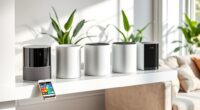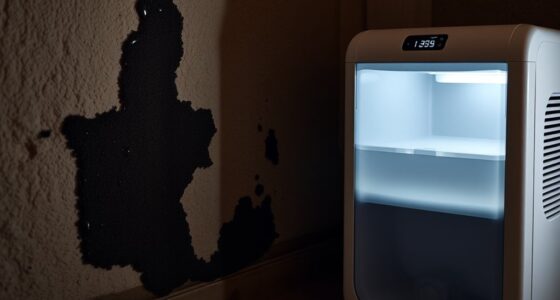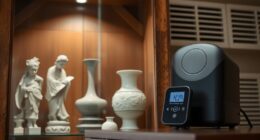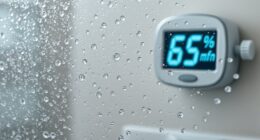To keep your musical instruments in top condition, maintain a humidity level between 40% and 60%. This range helps prevent wood from cracking, warping, or swelling, ensuring sound quality and longevity. Use a reliable hygrometer to monitor levels often and adjust with humidifiers or dehumidifiers as needed. Proper storage in a stable environment is essential. If you want to learn more about perfect climate control for your instruments, keep exploring these tips.
Key Takeaways
- Maintain humidity levels between 40% and 60% for optimal instrument preservation.
- Avoid fluctuations outside this range to prevent wood cracking or swelling.
- Use reliable hygrometers to monitor humidity regularly.
- Adjust climate control devices seasonally to sustain consistent conditions.
- Store instruments in a stable, climate-controlled environment away from direct sunlight and moisture.

Maintaining proper humidity levels is essential for preserving the sound and longevity of your musical instruments. When you’re storing your instruments, the right climate control can make all the difference in preventing damage and ensuring they stay in ideal condition. Your storage environment needs to be carefully managed because fluctuations in humidity can cause wood to crack, glue to weaken, and finishes to peel. By controlling these factors, you protect your investment and keep your instruments sounding their best for years to come.
A stable environment with humidity levels between 40% and 60% is generally recommended for most musical instruments, especially those made of wood. If the humidity drops too low, the wood can become brittle and prone to cracking. Conversely, if it’s too high, swelling and warping may occur, which can affect the instrument’s playability and tone. The key to maintaining this balance is regular monitoring of your storage environment. Using a reliable hygrometer allows you to keep close tabs on humidity levels and make adjustments as needed.
Climate control is vital because it helps you create a consistent storage environment. If you’re in an area with significant seasonal changes, consider investing in a humidifier or dehumidifier to regulate the air around your instruments. For example, during winter months when indoor heating dries out the air, a humidifier can add necessary moisture. In humid summer months, a dehumidifier can prevent excess moisture from damaging your instruments. Additionally, storing your instruments in a climate-controlled room or closet can help buffer against rapid changes in humidity and temperature.
You should also pay attention to where you store your instruments. Avoid places with direct sunlight, near heating vents, or in basements prone to dampness. Instead, choose a cool, dry, and stable spot where fluctuations are minimal. Using cases with built-in humidity control or placing desiccants or humidifiers inside your instrument cases can provide extra protection. These small accessories help maintain a consistent microclimate around your instrument, reducing the risk of damage caused by environmental shifts. Environmental control is a crucial factor in safeguarding your instruments over time.
Frequently Asked Questions
How Does Temperature Affect Optimal Humidity for Instrument Storage?
Temperature effects play a vital role in maintaining humidity stability for your instruments. As temperatures rise, the air can hold more moisture, which may cause your instrument to swell or warp if humidity levels aren’t adjusted. Conversely, cooler temperatures reduce moisture retention, risking cracks and dryness. You need to monitor both temperature and humidity closely, ensuring they stay balanced to keep your instrument safe and in ideal condition.
Can Fluctuating Humidity Levels Damage Instruments Over Time?
Yes, fluctuating humidity levels can damage your instruments over time. When humidity varies, wood expansion and contraction occur, risking cracks or warping. Additionally, high humidity can promote mold growth, which damages both wood and finish. These changes weaken the instrument’s structure and sound quality. To protect your instruments, aim for stable humidity levels and avoid frequent fluctuations that cause these issues.
What Are the Signs of Humidity-Related Damage in Instruments?
You might notice wood expansion or cracking if humidity levels fluctuate, signaling damage. Metal parts could show corrosion, and your instrument may sound off due to warping. Keep an eye out for sticking keys or loose fittings as signs of moisture issues. Proper humidity helps with corrosion prevention and keeps wood stable, ensuring your instrument stays in good shape and sounds its best over time.
Are There Specific Humidity Levels for Different Types of Instruments?
You should aim for specific humidity levels based on your instrument’s wood types and case materials. For wooden instruments, keep humidity around 45-55% to prevent cracking or warping, while for those with delicate case materials, slightly lower levels might be better. Check manufacturer guidelines, as different wood types like spruce or mahogany respond differently. Maintaining proper humidity helps preserve your instrument’s tone, structure, and longevity.
How Often Should I Check and Adjust Humidity in Storage Areas?
Think of your storage as a ship steering through changing seas. You should check your humidity levels at least monthly, especially during seasonal shifts. Use reliable humidity monitoring tools like hygrometers to keep track. When you notice fluctuations, make seasonal adjustments to maintain a stable environment. Regular checks help prevent damage, ensuring your instruments stay in top shape, just like a well-maintained vessel stays afloat in rough waters.
Conclusion
To keep your musical instruments singing like new, aim for humidity levels between 40-60%. Think of it as tending a delicate garden—too dry, and your instrument wilts; too damp, and it risks rot. When you find that perfect balance, it’s like giving your instruments a cozy, sunlit home where they can thrive and resonate with their fullest, most beautiful sound. Keep the humidity just right, and your music will always be in harmony.









